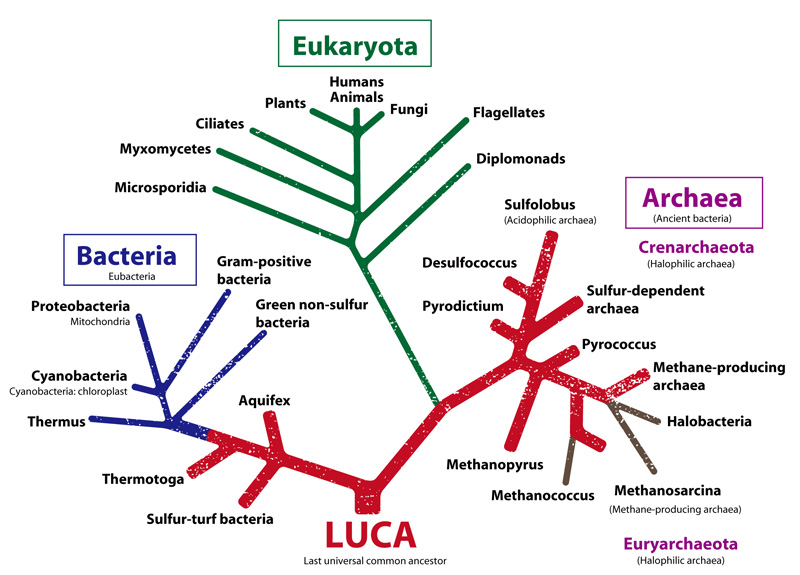
An evolutionary tree based on innovative concepts
The red line signifies thermophiles that prefer temperatures over 60°C.
"Subseafloor biosphere" is not a concept from the realm of science fiction, but an ecosystem, the existence of which has come to light, albeit vaguely, only recently. It comprises microbial communities that exist in the voids among mineral grains in the Earth's crust, but the mechanisms of their metabolism have remained largely unknown. The void ratio of rocks is relatively low, up to 10%, but if we consider the thickness of the Earth's crust layer from the surface down to the depths in which the threshold temperature for sustenance of life is maintained, the hypothesis that the biomass of the subsurface biosphere exceeds that of all living organisms on the Earth's surface and oceans has yet to be disproven.
So is the subsurface biosphere a dark "underworld" that is utterly devoid of change and movement and totally severed from life on the surface of the Earth? Efforts to answer this question have yielded facts that defy our common knowledge. As it turns out, this newly-discovered ecosystem is the oldest on Earth, and researchers believe it may hold some links to the very origin of life. It all began with the discovery of seafloor hydrothermal activities in the late 1970s. Until then, scientists considered archaea to be somewhat bizarre microorganisms that were somehow just barely able to survive in harsh environments such as volcanic gas-emitting zones and hot springs, which are characterized by high temperatures, low pH, and high salt concentration. After the discovery of seafloor hydrothermal activities, however, various types of ubiquitous archaea were found in deep-sea hydrothermal vents caused by such activities. Through genome analyses, scientists have identified these areas as the most genetically-diverse zones in the environment of our planet. Furthermore, the fact that archaea branched out from around the roots of the universal genealogical tree, or, in other words, close to the common ancestral origin of all living beings, suggests that archaea are probably remnants of the earliest life forms on Earth.
The Earth's environment today is a low-temperature aerobic world flooded with sunlight. In contrast, seafloor hydrothermal systems are part of a high-temperature anaerobic world submerged in darkness, which is reminiscent of the Earth's environment 3.9 billion years ago when life emerged. There is, however, one significant difference. Today, just a step up, immediately above the seafloor, there is a virtually unlimited expanse of low-temperature oxidative sea water. Some 2.2 billion years ago, the levels of oxygen in the atmosphere and dissolved oxygen in the oceans, released as byproducts of photosynthesis, increased dramatically, but scientists believe that until then free oxygen did not exist in the environment. The seafloor is the boundary plane where the anaerobic environment and the aerobic environment come into contact with each other. A more detailed examination reveals that these two environments interfuse in some spots near the seafloor, and, as a result, significant environmental gradients are formed in their temperature, pH, and oxidation-reduction potential. Such environmental gradients constitute a critical condition for the survival of all living organisms. That is why they are a key factor behind the extensive diversity in the microbial communities composed of autotrophic and heterotrophic organisms that inhabit seafloor hydrothermal areas.
Here, we must point out one important fact. Seafloor hydrothermal activities represent a recurring phenomenon throughout the history of Earth, but an examination of individual geothermal activities reveals that their duration is quite short. Mid-ocean-ridge hydrothermal activities account for 80% of all seafloor hydrothermal activities around the world, and there are numerous examples of such mid-ocean-ridge activities, where the hydrothermal temperatures and the volume of reductive material declined over a period between one and several years. Surveys of the duration of hydrothermal activities in island arcs near Japan have come up with slightly higher figures - between 10 and 10,000 years. At any rate, it would appear that microorganisms, which cannot move about on their own, commonly experience disruption of the supply of nutrients received from the hydrothermal environment.
Such happenings are major incidents, equivalent to a sudden disappearance of sunlight and termination of primary production through photosynthesis in terms of terrestrial life forms. The microorganisms in the subsurface biosphere are able to adapt perfectly to such drastic transformations. Moreover, they have endured environmental changes, such as evaporation of the global oceans due to a collision with a massive meteorite, and global glaciation due to severe climate fluctuations, surviving on their own until the appearance of larger organisms some 540 million years ago.
Archaea, which are in the core of the subsurface biosphere, have evolved at a pace much slower than that of bacteria or eukaryotes. We should emphasize, however, that all microorganisms living today, including archaea, are not protobionts. Rather, they have experienced the 3.9-billion-year-long history of life together with human beings, and have successfully survived by continuing to adapt perfectly to the ecological environment in the seafloor hydrothermal ecosystems, which are the cradle of life on Earth.
The thriving evolution of human beings, whose population has been increasing at an explosive pace, is a symbol of the success of terrestrial biospheres. These biospheres, however, are extremely vulnerable to environmental changes and are sustainable only in the conditions of a stable global environment and uninterrupted supply of food, water, energy, and mineral resources. What can be said with certainty is that, even if an apocalypse occurs on Earth several hundred years or several hundred millions of years from now, wiping away all living organisms on the surface of the planet, the subsurface biosphere will survive as the last refuge of life. I wonder if I am alone in my awe at the magnificence of the evolution of life, which has given birth to organisms with radically opposing strategies for survival and maintains mechanisms to ensure their continued existence? Furthermore, if we accept the panspermia hypothesis, according to which life traveled to Earth aboard meteorites from Mars, there is a possibility that organisms in the subsurface biosphere may not have entirely lost their ability to travel through space. Maybe in the future it will be microorganisms from the subsurface biosphere, and not humans, who will leave Earth and settle on other planets.




